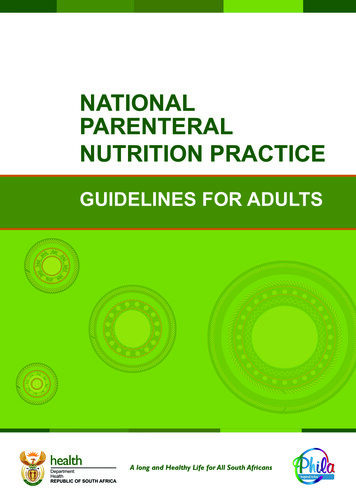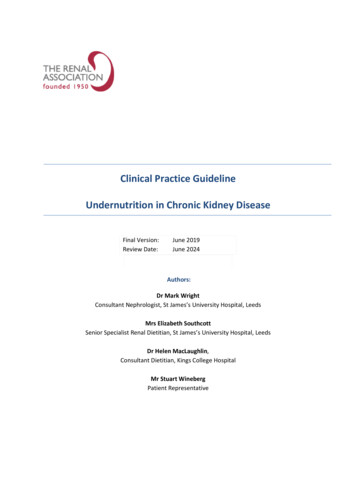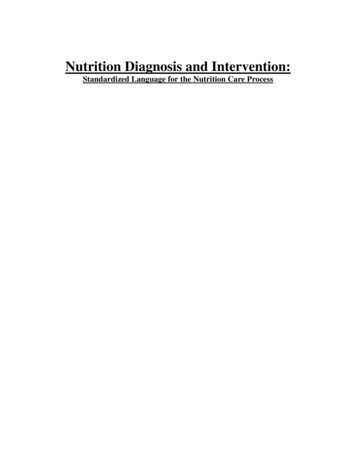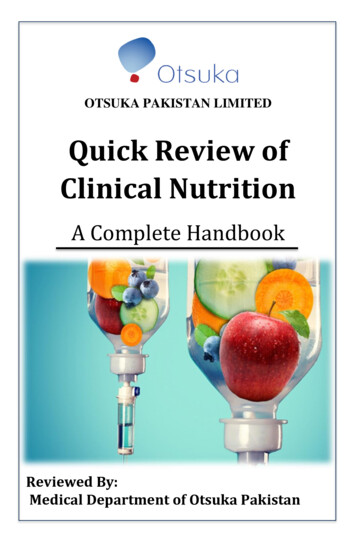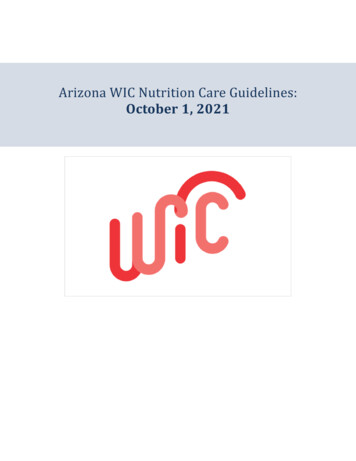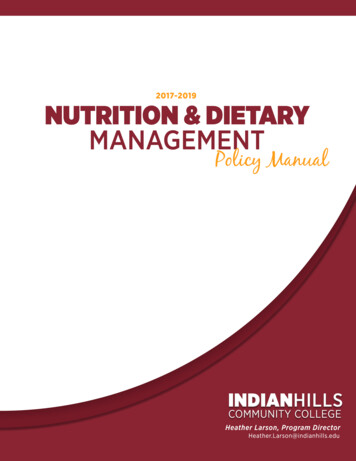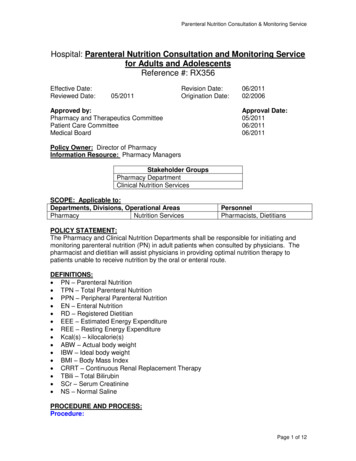
Transcription
Parenteral Nutrition Consultation & Monitoring ServiceHospital: Parenteral Nutrition Consultation and Monitoring Servicefor Adults and AdolescentsReference #: RX356Effective Date:Reviewed Date:05/2011Revision Date:Origination Date:Approved by:Pharmacy and Therapeutics CommitteePatient Care CommitteeMedical Board06/201102/2006Approval Date:05/201106/201106/2011Policy Owner: Director of PharmacyInformation Resource: Pharmacy ManagersStakeholder GroupsPharmacy DepartmentClinical Nutrition ServicesSCOPE: Applicable to:Departments, Divisions, Operational AreasPharmacyNutrition ServicesPersonnelPharmacists, DietitiansPOLICY STATEMENT:The Pharmacy and Clinical Nutrition Departments shall be responsible for initiating andmonitoring parenteral nutrition (PN) in adult patients when consulted by physicians. Thepharmacist and dietitian will assist physicians in providing optimal nutrition therapy topatients unable to receive nutrition by the oral or enteral route.DEFINITIONS: PN – Parenteral Nutrition TPN – Total Parenteral Nutrition PPN – Peripheral Parenteral Nutrition EN – Enteral Nutrition RD – Registered Dietitian EEE – Estimated Energy Expenditure REE – Resting Energy Expenditure Kcal(s) – kilocalorie(s) ABW – Actual body weight IBW – Ideal body weight BMI – Body Mass Index CRRT – Continuous Renal Replacement Therapy TBili – Total Bilirubin SCr – Serum Creatinine NS – Normal SalinePROCEDURE AND PROCESS:Procedure:Page 1 of 12
Parenteral Nutrition Consultation & Monitoring stAction:1. Obtain the names of patients receiving TPN in his/her patientcare area of practice via an electronic health record system list.2. Estimate the patient’s nutritional caloric needs using validatedenergy requirement calculation methods.3. Consider the patient’s current nutrition status, disease states,clinical status, lab values, medications and IV fluids wheninitiating or adjusting a TPN.Pharmacist Role for All Following Categories:1. Prior to initiating or adjusting TPN, the pharmacist will successfully pass a generalTPN competency exam.2. Pharmacists will monitor fluid, electrolyte, acid-base status and blood glucose inpatients using standard laboratory values.3. Pharmacist will leave a progress note if one of the criteria below is met:a. TPN being initiatedb. TPN formula is changed or modifiedc. Within 24 hours of patient transfer in level of cared. Every 48 hours in the absence of criteria a,b, or c above4. Pharmacists will write orders for macronutrients and electrolytes per TPNguidelines listed in this policy.5. Changes to the amount of a macronutrient or electrolyte in a continuous TPN willbe effective with the next continuous TPN bag to be hung at 2200 daily unless theclinical condition requires these changes to be made sooner.6. Changes to the amount of macronutrient or electrolyte in a cyclic TPN will beeffective the next cyclic TPN bag to be hung at 2000 daily unless the clinicalcondition requires these changes to be made sooner.7. Pharmacists may order labs or procedures deemed necessary to provide optimalnutrition management including electrolytes, electrolyte protocols, renal andhepatic function tests, triglycerides, serum glucose checks, CRP, prealbumin andindirect calorimetry.8. When signing TPN and lab orders, pharmacists will enter the name of thephysician who placed the original consult order in the Ordering Provider fieldand "Protocol/ No Co-Sign/ Follow Up" in the Authorizing Provider field.Estimate EnergyRequirements1. Determine patient’s weight:a. Actual Body Weight in kg (ABW) – the patient’s actual bodyweight at hospital admission will be used for all energyrequirement and protein requirement calculations exceptwhere specifically stated.b. Ideal Body Weight in kg (IBW) – Hamwi Method – thepatient’s ideal body weight will be used in specificcircumstances such as obesity, pregnancy, chronichemodialysis as outlined in Appendix A.Male: 48 kg 2.7 x (height in inches - 60)Female: 45.5 kg 2.3 x (height in inches - 60)c. Obese BMI 302. Calculate EEE/24 hours using validated energy requirementcalculation methods relevant to patient’s clinical condition. (seeAppendix A)Page 2 of 12
Parenteral Nutrition Consultation & Monitoring Service3. Estimate stress factor, if applicable. (see Appendix A)Fluid Volume1. TPN should not be used to completely satisfy fluid requirements.Most TPNs infuse at a rate of 50-75 mL/hr. If additional fluid isrequired, physicians should order a maintenance fluid in additionto TPN.2. Assess need for fluid restriction (specifically, CHF, renal failure)and concentrate TPN as able.1. See Appendix B for estimated protein requirements in variouspatient populations and disease states.2. Prealbumin (t½ 2-3 days) is preferred over albumin as anindicator of nutritional status (t½ 20 days). Prealbumin will beEstimate Proteinchecked a minimum of once weekly.Requirements and3. C-Reactive Protein: recommended if prealbumin does not trendSupportupward in the absence of other clinical explanations.Recommendations4. Monitor BUN and SCr and consider limiting protein when risk ofnephrotoxicity is high (i.e. acute or chronic renal insufficiency).Amino Acids: 45. Specialized hepatic amino acid formulas (Branched Chain Aminokcal/gAcids) will be considered in patients with Grade II hepaticencephalopathy.6. Consider checking nitrogen balance to monitor protein utilization(1g N2 6.5 g protein) in appropriate patients.1. Lipid bottle and tubing will be changed daily at 22:00 forcontinuous TPN and 20:00 for cyclic TPN unless otherwisespecified by a physician or pharmacist.2. The maximum hang time for each lipid bottle is 24 hours.3. Optimal dose: 25-30% of total kcal.Estimate Lipid4. Required minimum of 4-10% of total kcal to prevent essential fattyRequirements andacid deficiency (EFAD).Support5. Baseline and weekly triglyceride (TG) level will be monitored andRecommendationsshould remain 400 in order for lipids to be infused.6. When TG 400, give 500 kcal (250 mL) of lipid once to twiceLipids: 9 kcal/gweekly to prevent EFAD. Monitor TG at least twice weekly in this2 kcal/mLpatient population.7. For patients receiving propofol, lipids may be held or the rateadjusted as deemed appropriate by the pharmacist. Triglycerideswill be monitored to determine need for adjustments, starting orstopping lipids due to concurrent use of propofol.Page 3 of 12
Parenteral Nutrition Consultation & Monitoring Service1. Dextrose will provide the balance of required kcals not providedby protein and lipids.2. Dextrose should provide approx 50-60% of total kcals (2-5mg/kg/min).3. MAXIMUM concentration of dextrose will be 10% peripherally and35% centrally.4. At the time of TPN initiation, if the patient is not currently oncorrective dose insulin or an insulin infusion protocol and does nothave a hospitalist or intensivist currently consulted, thepharmacist will initiate subcutaneous corrective dose insulinusing regular insulin per the TPN order set and enter the standardlow scale doses as follows:EstimateCarbohydrate(dextrose)Requirements andSupportRecommendationsDextrose: 3.4kcal/gBlood Glucose 6060-119120-149150-199200-249250-299300-349 350Add’l InsulinSee hypoglycemia protocolNo insulin0 units1 unit2 units3 units4 units; call physician if 300 x 25 units and call a physician5. Further adjustments to insulin orders will be made by a physician.6. If two consecutive blood glucose levels are 150 mg/dL, thepharmacist will notify the physician and recommend ahospitalist consult for management of hyperglycemia.Pharmacists will also decrease dextrose in the TPNformulation as able to minimize further hyperglycemic risk.7. At the time of TPN initiation, if the patient does have currentinsulin orders and/or a hospitalist or intensivist consult, thepharmacist will notify the physician of the TPN initiation so he/shecan review and adjust the insulin orders as needed.8. Calculate non-protein kcal:nitrogen ratio (NPK:N2) to determine ifthere is adequate kcal necessary for proper protein utilization.- Recommended NPK:N2 for maintenance 150:1, mild tomoderate stress 90 -120:1, severe stress/critical illness 70100:1.Page 4 of 12
Parenteral Nutrition Consultation & Monitoring ServiceElectrolytesStandard amount in TPN is 30-80 mEq/L (1/2 NS 77mEq/L)Pharmacists will initiate TPN with standard Na unless physicianand/or disease state requires otherwise.Sodium (Na)Normal SerumValue: 135 – 145mEq/LHyponatremia1. Pharmacist will consider fluid status and disease states inpatients with mild to moderate hyponatremia (Na 125-135). Ifpatient is fluid overloaded, no adjustments will be made.2. If patient is determined to be in normal fluid balance and 2consecutive Na levels are low, pharmacist may increase Na innext TPN.Hypernatremia1. Pharmacist will consider fluid status of the patient and reduce Nain next TPN as appropriate.2. Pharmacist will consider using a low sodium amino acidformulation to minimize Na content of TPN as appropriate.Standard amount in TPN is 30-40 mEq/LPharmacist will initiate TPN with standard K unless physician and/ordisease state requires otherwise.Potassium (K)Normal SerumValue: 3.5 - 5.1mEq/LHypokalemia1. K replacement protocol will be ordered at the initiation ofTPN for all patients with the exception of dialysis patients.2. K in TPN will be increased per pharmacist discretion based on labvalue, diuretic use, other IV fluids, and total K replaced perprotocol.Hyperkalemia1. For K 6 or symptomatic hyperkalemia, TPN rate will be reducedor stopped (if TPN contains K) and pharmacist will adjustamount of K in next TPN per his/her discretion.Standard amount in TPN is 4-12 mEq/LPharmacist will initiate TPN with standard Mg unless physician and/ordisease state requires otherwise.Magnesium (Mg)Normal SerumValue: 1.8-2.6mEq/LHypomagnesemia1. Mg replacement protocol will be ordered at the initiation ofTPN for all patients with the exception of dialysis patients.2. Mg in TPN will be increased per pharmacist discretion based onlab value and total Mg replaced per protocol.Hypermagnesemia1. If patient experiences symptomatic hypermagnesemia, TPN ratewill be reduced or stopped (if TPN contains Mg) and pharmacistwill adjust amount of Mg in next TPN per his/her discretion.Page 5 of 12
Parenteral Nutrition Consultation & Monitoring ServiceCalcium (Ca)Normal SerumValue: 8.5 - 10.5mg/dLIonized Calcium(iCa)Normal SerumValue:1.19 – 1.3 mMol/LStandard amount in TPN is 5-10 mEq/LPharmacist will initiate TPN with standard Ca unless physician and/ordisease state requires otherwise.- To minimize risk of precipitate formation in TPN solution:Ca (mEq/L) Phos (mMol/L) 45- To minimize risk of precipitate formation in soft tissues:Ca (mg/dL) x Phos (mMol/L) 60Hypocalcemia1. Pharmacist will consider patient’s serum albumin and may orderan ionized Ca prior to increasing Ca in next bag of TPN.2. Ca in TPN will be increased per pharmacist discretion based onlab value and any replacement doses given.HypercalcemiaIf patient experiences symptomatic hypercalcemia TPN rate will bereduced or stopped (if TPN contains Ca) and pharmacist will adjustamount of Ca in next TPN per his/her discretion.Standard amount in TPN is 10-15 mMol/LPharmacists will initiate TPN with standard Phos unless physicianand/or disease state requires otherwise.- To minimize risk of precipitate formation in TPN solution:Ca (mEq/L) Phos (mMol/L) 45- To minimize risk of precipitate formation in soft tissues:Ca (mg/dL) x Phos (mMol/L) 60Phosphorus(Phos)Normal SerumValue: 2.4 - 4.7mMol/LHypophosphatemia1. Phos replacement protocol will be ordered at the initiation ofTPN for all patients with the exception of dialysis patients.2. Phos in TPN will be increased per pharmacist’s discretion basedon lab value and total Phos replaced per protocol.Hyperphosphatemia1. Pharmacist will decrease Phos in next TPN per his/her discretion.Note that lipid formulas contain phosphorus so patient maycontinue to receive some phosphorus even if it is removed fromTPN.- Both 10% and 20% lipid emulsions (i.e. propofol and Liposyn III )contain 15.5 mMol of phosphorus per literPage 6 of 12
Parenteral Nutrition Consultation & Monitoring ServiceStandard acetate:chloride ratio in TPN is 1:1Chloride &Acetate(Bicarbonate)Normal SerumValues: Cl: 98 110 mEq/LBicarbonate: 22 32 mEq/LMetabolic acidosis1. If severe, pharmacist should minimize chloride in TPN.2. If mild/moderate, the ratio may be adjusted per pharmacistdiscretion.Metabolic alkalosis1. If severe, pharmacist should minimize acetate in TPN.2. If mild/moderate, the ratio may be adjusted per pharmacistdiscretion.Multi-vitamin1. Pharmacist will order standard multivitamin with vitamin K unlessotherwise specified by the physician. (See Appendix C foringredients)2. Patients receiving anticoagulation with warfarin may remain onmultivitamin with vitamin K with careful monitoring of INR or CFXvalues.Trace Elements1. Pharmacist will order standard trace elements unless otherwisespecified by the physician. (See Appendix C for ingredients)2. Disease states where certain elements will be removed:a. Renal Dysfunction (SCr 2-3 unless patient is receivingdialysis): Consider removal of selenium and chromium if onlong-term TPN (10 days) due to a risk of accumulation.b. Hyperbilirubinemia (TBili 3-4): Consider removal of copperand manganese if on long-term TPN (10 days) due to a riskof accumulation.AdditionalSupplementationNo additional additives other than the standard multi-vitaminand trace elements as stated above will be added to any TPNformulation except those specifically stated in this section.Vitamin C1. Patient population: Wound healing of surgical incisions or stage 2or greater pressure ulcers may benefit from vitamin Csupplementationa. Pharmacist may add ascorbic acid 500-1,000 mg/day to TPNb. Patients with renal insufficiency who are not receiving dialysiswill receive a maximum of 500 mg/dayc. Patients with a history of or at risk for nephrolithiasis will notreceive additional ascorbic acidZinc1. Patient population: Wound healing of surgical incisions orpressure ulcers may benefit from zinc supplementation.a. Pharmacist may add zinc 5-10 mg/day to TPN2. Patient population: Patients with significant stool and/or GI fluidloss from diarrhea, ostomies, fistulas, etc. are at risk of deficiencyPage 7 of 12
Parenteral Nutrition Consultation & Monitoring Serviceand may benefit from supplementation.a. Pharmacist may add zinc 5-10 mg/day to TPN3. Patient population: Patients who receive propofol infusion for 5days are at risk of deficiency due to the chelating effects of EDTA.a. Pharmacist may add zinc 5 mg/day to TPNIf a patient has more than one of the above indications for zincsupplementation, a maximum of 10 mg/day will be added to TPN.Insulin1. Insulin may be added to the TPN bag at the physician’s discretionafter the TPN infusion has been at goal rate for at least 24 hours.2. Physicians will be responsible for making all insulin doseadjustments.3. Initiation of insulin and dose adjustments will be communicated tothe pharmacist either verbally or via ERx 292861 “TPN changesfrom provider to pharmacy”.4. For any TPN containing insulin, all changes made by pharmacy tothe dextrose concentration will be communicated to the physician.5. When any TPN containing insulin is discontinued, pharmacy willcontact the physician for new insulin orders if not alreadyaddressed.Osmolarity (forperipheral lineTPN)Total osmolarity for peripheral TPN must be 900 mOsm/L toprevent phlebitis.Osmolarity of substrates and additives:Amino Acids: 100 mOsm/gm% (e.g. 4% AA contributes 400mOsm/L)Dextrose: 50 mOsm/gm% (e.g. 8% dextrose contributes 400mOsm/L)Electrolytes: 1 mOsm/mEq (e.g. 20 mEq of K contributes 20mOsm/L)Lipids: Iso-Osmolar, can be given peripherally or centrallyAdministrationRateIn general, TPN will be initiated at ½ goal rate for 24 hours and thenincreased to goal rate.1. In patients deemed to be at risk for refeeding syndrome, theTPN will be initiated at a maximum of ½ goal rate for aminimum of 24 hours and then increased to goal rate perpharmacist discretion.2. The maximum hang time for all TPN bags is 36 hours.3. In patients recently on TPN or changing from continuous tocyclic TPN, the titration to goal rate may be accelerated perpharmacist discretion.4. If TPN is to be discontinued, cut TPN rate in half for 2-4 hoursand then discontinue or per physician recommendations.5. Lipids do not need to be tapered when discontinuing.PROTOCOL: N/APage 8 of 12
Parenteral Nutrition Consultation & Monitoring ServiceFORMS: N/AALGORITHM: N/AADDENDA:Appendix A – Calculations for Estimation of Energy Expenditure (EEE)Appendix B – Estimated Daily Protein RequirementsAppendix C – TPN Standard Product FormulationsFAQs:Parenteral nutrition (PN) delivers nutrients intravenously to patients unable to receiveenteral nutrition (EN) or who are unable to maintain their nutritional status solely byenteral means. This policy and procedure outlines the process and expectations forpharmacists and Dietitians providing consultation for total and peripheral perenteralnutrition.REFERENCES: ASPEN Nutrition Support Core Curriculum. 2007. American Society for Parenteraland Enteral Nutrition, Chapters 2, 28, 30, 35. . Manual of Clinical Nutrition Management 2008 Morrison Management Specialists,Inc. Modified for Allina Hospitals and Clinics. Dipiro JT et al. Pharmacotherapy: A Pathophysiologic Approach, 5th edition. Section18 Nutritional Disorders, Chapters 135, 137, and 139. Dickerson RN. Nutritional support in the hospitalized obese patient. HospitalPharmacy 1997;32(2):256-69, 275. Choban PS et al. Nutrition support of obese hospitalized patients. Nutrition in ClinicalPractice 1997;12(4)149-54. Kraft MD et al. Treatment of electrolyte disorders in adult patients in the intensivecare unit. Am J Health-Syst Pharm 2005;62:1663-82. Dickerson RN. Hypocaloric feeding of obese patients in the intensive care unit. CurrOpin Nutr Metab Care 2005,8:189-196 KDOQI Guideline 21, delines updates/nut a21.html.Accessed 4/22/09. Scholl D, Langkamp-Henken B. Nutrient Recommendations for Wound Healing.Journal of Intravenous Nursing 2001;24(2):125-132. AstraZeneca. Diprivan 1% Prescribing Information. Revised August 2005. American Dietetic Association Nutrition Care Manual, c2006.Related Regulations and Laws: N/AAdditional Search Terms: hyperalimentationRelated Policies:Name of PolicyTPN FormulationContent IDRX329Policies Replacing: N/APage 9 of 12
Parenteral Nutrition Consultation & Monitoring ServiceAppendix A – RX356Calculations for Estimation of Energy Expenditure (EEE)For all equations:A age in yearsW actual body weight in kg regardless of BMI (i.e. do not adjust weight if obese)H height in cmS sex (male 1, female 0)T trauma (present 1, absent 0)B burns (present 1, absent 0)O obesity BMI 27 kg/m2 (present 1, absent 0)Non-ventilator dependent, BMI 30:Mifflin-St. Jeor EquationMen: REE 10(W) 6.25(H) – 5(A) 5Women: REE 10(W) 6.25(H) – 5(A) – 161EEE REE stress factorStress factorWeight maintenance or mildly stressed patient:- Routine surgeryCancer patient:Minor infection or moderately stressed patient:Severely stressed, mechanically ventilated:- Sepsis or multiple traumaAcute renal failure patient:Chronic renal failure patient:Burn patient:1.1 – 1.31.1 – 1.51.2 – 1.31.3 – 1.51.5 – 21 – 1.52BMI 30; Non-ventilator and ventilator dependent22 kcal/kg IBWNon-ventilator dependent, hemodialysis30-35 kcal/kg ABWNon ventilator-dependent, pregnant36-40 kcal/kg IBWVentilator-dependent patients, BMI 30Ireton-Jones (1992 version)Ventilator dependent: EEE 1925 – 10(A) 5(W) 281(S) 292(T) 851(B)DO NOT use stress factor with this equationNote: When a patient’s status changes from non-ventilated to ventilated (or vice versa),energy requirements will be recalculated with the appropriate formulaPage 10 of 12
Parenteral Nutrition Consultation & Monitoring ServiceAppendix B – RX356Estimated Daily Protein Requirements**All weights are in kg of actual body weight unless otherwise indicated**Maintenance, healthy, no stress0.8 – 1 g/kgMild stress1 – 1.2 g/kgModerate stress, protein repletion, elderly1.3 – 1.5 g/kgSevere stress, extensive repletion, burns1.5 – 2.5 g/kgProtein needs in specific disease states:Hepatic Failure0.8 – 1 g/kg- hepatic encephalopathy 0.8 g/kg – consider BCAAAcute Renal Failure0.8 – 1.2 g/kgNote: patients with these disease states are often not able to tolerate thehigher protein loadChronic Renal Failure (non-dialysis)0.6 – 0.8 g/kgHemodialysis1.2 – 1.5 g/kg- dependent upon stress, malnutrition, & dialysis regimenCRRT1.5 – 2.5 g/kgObesity – BMI 30-402 g/kg/IBW (adjust for organdysfunction)Obesity – BMI 402.5 g/kg/IBW (adjust for organdysfunction)Pancreatitis1 – 1.5 g/kgRespiratory Failure or Diabetes1 – 1.5 g/kgSepsis1.5 – 2.5 g/kgShort-bowel Syndrome, IBD1 – 2 g/kgHyperemesis gravidarum1.2 – 1.7 g/kgPage 11 of 12
Parenteral Nutrition Consultation & Monitoring ServiceAppendix C – RX356TPN Standard Product FormulationsDextrose: 70% stock solutionAmino acids:Standard: Aminosyn II – 15% stock solutionSodium-free: Clinisol – 15% stock solutionBranched chain: BranchAmin – 4% stock solutionLipids: Liposyn III 20%Multivitamin: Infuvite Adult (per 10 mL added to each TPN bag)Ascorbic Acid (C): 200 mgVitamin A: 3,300 International UnitsVitamin D3 (cholecalciferol): 200 International UnitsThiamin (B1): 6 mgRiboflavin (B2): 3.6 mgPyridoxine (B6): 6 mgNiacin (B3): 40 mgPantothenic acid: 15 mgVitamin E: 10 International UnitsVitamin K: 150 mcgFolic acid: 600 mcgBiotin: 60 mcgCyanocobalamin (B12): 5 mcgTrace Elements: Multitrace - 5 (per 3 mL added to each TPN bag)Zinc: 3 mgCopper: 1.2 mgManganese: 0.3 mgChromium: 12 mcgSelenium: 60 mcgPage 12 of 12
corrective dose insulin or an insulin infusion protocol and does not have a hospitalist or intensivist currently consulted, the pharmacist will initiate subcutaneous corrective dose insulin using regular insulin per the TPN order set and enter the standard low scale doses as follows: Blood Glucose Add'l Insulin 60 See hypoglycemia protocol

